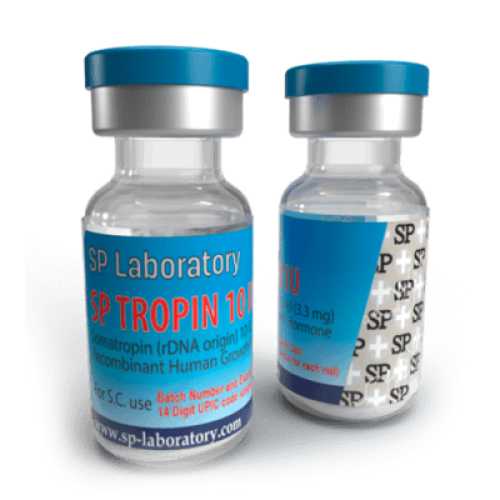- Active substance: somatothropine
- Manufacturer: SP Laboratory
- Unit: 1vials (3.33mg/ml) TropinActive substance: SomatropinOther names: HGH, Tropin, Somatropin, Genotropin, Humatrope, Nutropin, OmniTrope
Active half-life2.5-3 hours
Human Growth Hormone (HGH) is well-regarded as one of the most advantageous hormones produced by our bodies, and it is highly sought after in its artificial form. In this form, HGH mirrors the hormone produced naturally, making it not just one of the most advantageous exogenous hormones, but also one that is widely tolerated by both genders. This high tolerance applies to both medical and performance-enhancing applications.
Effects of Somatropin:
The benefits of Human Growth Hormone are remarkable. Supplementing with Somatropin can lead to improvements in various aspects of physical health, sometimes significantly. In clinical settings, HGH is primarily utilized to treat conditions such as pituitary dwarfism in children or to address HGH deficiencies in adults, which may arise from pituitary tumors or a natural decline in production associated with aging. Additionally, HGH is used for patients with HIV or AIDS and has shown considerable benefits in various muscle-wasting disorders. Synthetic HGH is also beneficial for burn victims, those with short bowel syndrome, and individuals with Prader-Willi syndrome, though its most prevalent application is in anti-aging therapy. The potential of HGH in countering aging effects becomes abundantly clear.
In athletic performance contexts, HGH has quickly gained a reputation as a highly desirable hormone. It exhibits strong anabolic properties; however, when used alone at moderate dosages, it may not lead to significant muscle growth. To maximize performance gains, users often combine it with anabolic steroids, as these substances work synergistically. Nevertheless, even on its own, Human Growth Hormone enhances recovery more effectively than most other exogenous hormones and provides a notable boost to metabolism. Regarding healing, HGH possesses substantial restorative properties that can benefit nearly every part of the body.
In recent years, Human Growth Hormone has been referred to as the "fountain of youth," and the evidence for this claim is compelling when observing HGH's effects. Although it cannot stop aging, it can certainly make the aging process more manageable. Overall, there are very few healthy adults who wouldn’t gain from HGH supplementation, whether for performance or everyday benefits. To illustrate, the effects of Human Growth Hormone in both men and women can include: reduced body fat, improved ability to maintain healthy body composition, a more toned physique, boosted metabolic rate, enhanced sense of wellness, healthier skin, better sleep patterns, increased bone density, elevated energy levels, stronger joints, increased lean muscle growth, quicker recovery rates, and greater tendon strength.
Side effects:Potential side effects include excessive water retention, joint discomfort, headaches, carpal tunnel syndrome, hypothyroidism, nausea, dizziness, respiratory infections, numbness in the skin, and irritation at the injection site. In cases of HGH misuse, there may be enlargement of the hands, feet, and jaw, and in severe cases, expansion of internal organs and short-term type-2 diabetes.How to use:Human Growth Hormone is administered through injections, either subcutaneously or intramuscularly. The bioavailability of HGH when injected subcutaneously is roughly seventy-five percent, while intramuscular injections provide a bioavailability of approximately sixty-three percent. The method of administration also affects the hormone's half-life; when injected subcutaneously, the half-life is around 3.8 hours, whereas intramuscular injections yield a half-life of about 4.9 hours. Despite the relatively short half-life, the overall effects persist significantly longer due to marked increases in IGF-1 production that extend beyond the twenty-four-hour timeframe.
In therapeutic situations, typical dosage for men ranges from 1 to 3 IU per day, with some instances reaching 4 IU per day, although that is less common. Women typically receive doses between 1 to 2 IU per day, and in long-term anti-aging treatments, it may be slightly less than 1 IU per day.
For athletes seeking performance enhancements, HGH doses can vary widely. Male athletes generally take 2 to 4 IU per day, benefiting from features such as fat loss and enhanced recovery. When combined with anabolic steroids, the effectiveness of steroid cycles increases significantly due to the synergistic effects between HGH and steroids. Female users can achieve the same benefits with 1 to 2 IU per day.
Even though the doses mentioned earlier offer considerable benefits, for notable muscle growth in performance scenarios, higher dosages are often required. Most men will need 6 to 8 IU per day over an extended duration. While higher dosages can lead to greater results, they may also increase the risk of adverse side effects. Women aiming for substantial growth may consider 3 to 4 IU per day.
Regardless of total dosages, Human Growth Hormone does not deliver immediate results. It is ineffective if used only for short durations. To foster fat loss and enhance recovery, users should aim for a minimum of 8 to 12 weeks of administration, with 16 weeks being preferable. For optimal anabolic growth, continuous HGH therapy at an appropriate dosage for at least six months is necessary. In therapeutic contexts, particularly for anti-aging, usage may be sustained indefinitely, often involving long-term treatment plans that last most of the year.

